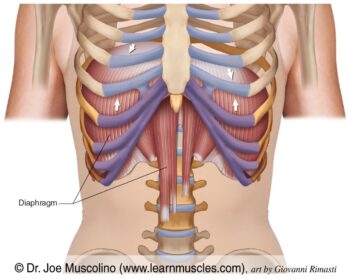
The diaphragm is a large, dome-shaped muscle that separates the thoracic and abdominal cavities. It is our primary breathing muscle. When you inhale, the diaphragm contracts and moves downward towards the abdominal cavity. This expands the thoracic cavity, creating space in the lungs for air to rush in and equalize the intrapulmonary pressure. When you exhale, the diaphragm releases and moves up, and carbon dioxide is expelled.
You may have taken a yoga class and heard the teacher say “breathe into your belly” – of course, we’re not literally breathing air into the belly. What we’re doing is softening the abdominals so that the diaphragm CAN drop down on the inhale.
Instead of sucking the abdominals in and breathing into the upper chest – which stresses the accessory breathing muscles (scalenes, sternocleidomastoid, obliques, abdominals, trapezius, and pectorals) and causes back, neck, and shoulder pain – we want to give the diaphragm space to do its job.
It might feel counterintuitive and even kinda weird to let your belly relax and “pooch” out – but if my yoga experience is any indicator, there’ll be plenty of time to tighten up those abs later (cough, plank pose, oof)! Belly-breathing is important because it activates the parasympathetic nervous system, facilitating healing.
Here are a couple of belly-breathing exercises that use your hands as guides/reminders:
Exercise One
- Place one hand on the belly and the other hand on the chest.
- Soften your belly and inhale – feel the air fill up the bottom of the lungs, then the middle, and finally the top.
- The hand on your belly should move outward before the hand on your chest lifts up.
- On the exhale, empty the lungs in reverse – top, middle, and lastly, the bottom.
Second Exercise
- Place both hands along the rib cage.
- Inhale and feel the rib cage expand outward – your hands will move away from one another.
- Exhale and allow your hands to move closer together back to their starting position.
Check out the video below for a short demonstration of both exercises.
* Picture of diaphragm muscle courtesy of Dr. Joe Muscolino.
